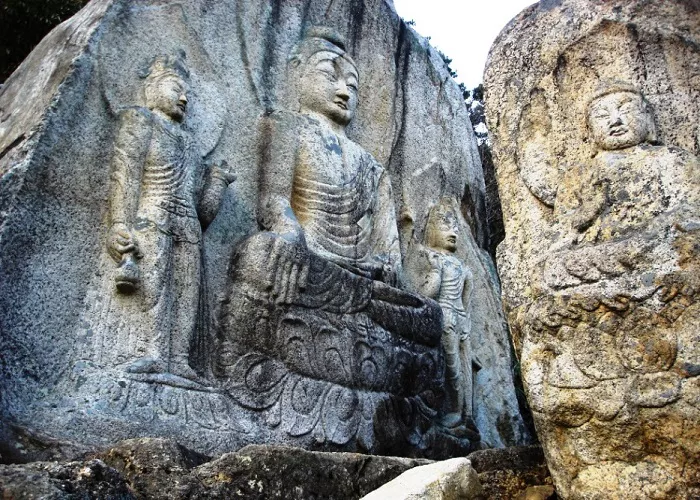Mount Nam in Gyeongju, North Gyeongsang Province, is home to a number of Buddhist sites, but few offer the serene, unstructured experience found at Chilbul Hermitage. Unlike the organized Templestay programs run by major temples across Korea, a visit to Chilbul can be an unexpected yet deeply rewarding journey for those seeking a more spontaneous spiritual retreat.
Nestled on the southeastern slopes of Mount Nam, Chilbul Hermitage—literally translated as “Seven Buddhas”—sits quietly amid the historical landscape of Gyeongju, the former capital of the Silla Kingdom (57 B.C. – 935 A.D.). The hermitage lies approximately seven kilometers from the Samneung Valley, accessible by a trail that crosses the mountain’s peak, descends into Yaksu Valley, and passes by the Yongjang Temple Site.
Despite its ancient aura, the current form of the hermitage only dates back to the 1930s. A local woman, foraging for wild mushrooms and herbs, discovered hidden rock-carved images of the Buddha, long obscured during the suppression of Buddhism under the Joseon Dynasty (1392–1910). In response, a Buddhist nun erected a modest hut on the site, laying the foundation for what would become the present hermitage. In 2009, a modern main hall was constructed, and in the same year, the rock carvings were officially designated as a National Treasure.
The main attraction at Chilbul Hermitage is a remarkable set of seventh- and eighth-century rock carvings. Two distinct stones feature a total of seven Buddha images. A smaller stone set before a towering rock wall bears four carvings, while the larger rock displays three prominent figures. The central image is believed to represent Amitabul (the Buddha of the Western Paradise), depicted seated atop a lotus flower. To the right is Gwanseeumbosal (the Bodhisattva of Compassion), identified by the bottle of sweet dew it holds. The third figure is presumed to be Daesaejibosal (the Bodhisattva of Wisdom and Power).
In front of this rock face stands a square stone known as “The Four Directional Buddhas,” with carvings on each side. Though the identities of the four figures remain a subject of scholarly debate, roof tile remnants suggest that these carvings were once enshrined within a temple building.
High above the hermitage, overlooking the valley like a silent guardian, is a 1.4-meter-high rock relief of a Bodhisattva. Believed to date from the late eighth century, the image is adorned with an ornate crown and flowing robes, seated in a meditative pose on a rock cliff. Its half-closed eyes gaze down contemplatively on Gyeongju, adding to the spiritual ambiance of the location.
To accommodate overnight visitors, a compact building was airlifted to the site in recent years, catering to the growing number of mountain hikers and spiritual seekers. At the time of a recent visit, the hermitage was inhabited by a Singaporean nun named Wonseong, who welcomed guests with tea and conversation. Discussions ranged from Buddhist teachings to meditation and the historical significance of the surrounding region.
Visitors were also invited to take part in a meditation session in front of the ancient rock carvings, followed by group meditation inside the main hall beneath a blooming cherry blossom tree. Later, they assisted with simple chores around the hermitage, including cleaning incense burners and tidying worship mats—tasks made necessary by the hermitage’s limited resident staff.
As evening fell, floodlights illuminated the rock carvings, revealing intricate details often missed in daylight. The interplay of light and shadow cast a new dimension on the ancient images, deepening the appreciation of these spiritual relics.
While structured Templestay programs remain an excellent introduction to Korean Buddhism, Chilbul Hermitage offers a more organic alternative. For those seeking quiet reflection in a historic and natural setting, the hermitage stands as a rare and rewarding destination—part sanctuary, part museum, and wholly unforgettable.


